ENTS,
The trip to the ENTS Rendezvous at Cook Forest was an ideal
opportunity to
gather useful information on several species. Our intention to
model eastern
hemlock and eastern white pine was fulfilled as was a revisit to
a tree in
West Virginia.
Topping the list for the trip north was a revisit to the Webster
Springs
sycamore in West Virginia. Jess Riddle, Ron Busch and I stopped
at this tree
and first measured it in 2004.
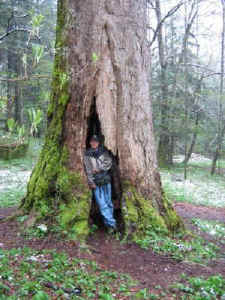 Photo from 2004
Photo from 2004
Jess and I returned this time
with the
reticle to model the volume of this enormous tree. With leaves
off and no
snow falling I was able to shoot the tree from two locations
close to 90
degrees apart and replicate all points within a maximum of 2.1
feet of each
other. For the base, Jess and I simply measured the diameter
through the
hollows in the trunk, and which point it was 9.4' across. To our
surprise,
the leaning trunk was nearly round in cross section based on the
reticle
measurements. As such, the two separate sessions yielded volumes
almost
identical. Differing by less than 14 cubic feet, the average of
the two
points indicate a trunk volume of 2214 cubic feet for the trunk
only. The
trunk was only 74 feet tall, at which point it was broken off.
At the point
of breakage, the trunk was still 5 feet in diameter! Huge limbs
ascended
from near the break and formed the remaining crown which is
still quite
impressive. I remeasured the height and obtained a solid 142.6
feet. Here
are examples of the trunk diameters (rounded):
Height Diameter
74.0' 5.0'
68.1' 5.2'
56.8' 5.3'
44.7 5.4'
31.2' 6.0'
15.8' 6.3'
8.4' 7.3'
7.1' 7.6'
3.9' 9.1'
0' 9.4'
After modeling the sycamore we stopped at Holly River State Park
following
the suggestion of Russ Richardson. We were not disappointed and
will post a
more detailed report soon. So on to Cook Forest!
The next day we met Dale Luthringer, Scott Wade, Anthony Kelly,
Carl Harting
and Brian Miller, biology technician, who works for Aboud Associates
Inc. in
Ontario at HQ and headed out to three sites
north of Cook Forest State
Park. The main goals were to model the Cornplanter Pine for
volume, a
large eastern hemlock in Tionesta Scenic Area, and another big
hemlock Dale
located in Hearts Content Recreation Area. The weather and Dales
driving (he
stayed out of ditches this time) allowed for the completion of
our goals. I
was richly rewarded with seeing thick, green and healthy
hemlocks; an
increasingly rare sight down here in the s. Appalachians.
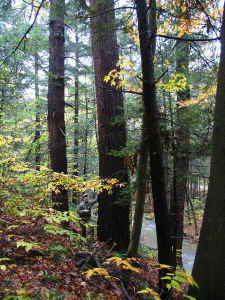 Cornplanter Pine 2005
Cornplanter Pine 2005
The Cornplanter Pine, dead since ca. 2004, had begun to lose
bark in some
sections but was essentially intact. After we zeroed the base
and set up a
pole for a target I lasered the height to 167.7 feet. The
surrounding forest
was dense but my single vantage point allowed for the modeling
of the two
top sections individually. Still over 8 feet in girth at 100
feet up, the
tree scaled an impressive 1011 cubic feet of trunk volume. Thus,
the
Cornplanter Pine has the distinction of being the first eastern
white pine
ENTS has documented to 1000 cubic feet of wood! By the sounds of
it, it will
be a member of a very exclusive club of white pines, with only a
scattering
of trees thought to achieve this size threshold. There is one
contender in
North Carolina, one in New Hampshire, and perhaps one in
Wisconsin. There is
a slim chance in Michigan and New York but overall, the eastern
white pine
is a slender tree in comparison to the mighty eastern hemlock.
It is
unfortunate we no longer have forests representing the
"great whites" of
historical dimensions.
We next went over to the Tionesta Scenic Area near Warren, PA.
Here I
modeled a gorgeous eastern hemlock Dale had located several
years ago.
Somehow it had shrunk in diameter since Dale last measured it,
but I found a
great reticle station and shot the volume to an impressive 838
cubic feet.
Although only 11.8 feet in girth at 4.5 feet the trunk was
slowly tapered,
allowing it to rack up the cubes and stake claim to the largest
known
hemlock in the Northeastern US! Second volume record of the day!
This
hemlock barely escaped annihilation from an F4 (5?) tornado that
wiped the
adjacent forest completely out just a few hundred yards away.
Dale pointed
out other tornado swaths during the day- very impressive
expressions of the
powers influencing our forests.
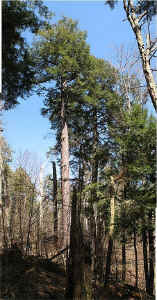 Tionesta Giant
Tionesta Giant
We again boarded Dale's DNR chariot and headed to Hearts Content
Recreation
Area, a 20 acre remnant old-growth white pine/hemlock forest. I
have read
about this place for nearly 15 years and have long wanted to see
it. I have
to say it is one of the finest forests I have ever seen. The
pines are
extraordinary and the hemlocks very dense and healthy. Although
suffering
from its small size with the encroachment of edge effects, deer
and exotic
plants the forest still maintains a sense of wildness and
grandeur. It felt
larger than it was, and sections of dense, pure hemlock were
engulfing to
the exclusion of sound.
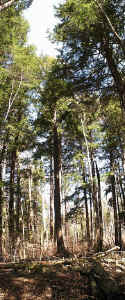
Happy Hemlocks at Tionesta Scenic Areas |
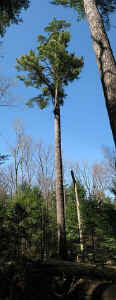
Hearts Pine |
The hemlock we had come to measure was determined to be small
relative to
the Tionesta tree, although a large one nearby with multiple
reiterations
was quite large. Since the reticle would not do it justice we
went on to
seek a larger tree. However, once Dale showed us the HUGE pine
on one edge
of the tract we could go no further. This tree had all the
qualities of
white pine rolled into one; tall, large, untapered, gnarly
reiterations, and
orange, platy bark. Furthermore, the tree was in the middle of a
blowdown
and was entirely visible and back dropped by the deep cobalt
sky. For lack
of better words, it was a perfect tree in a perfect situation on
a perfect
day! I set up the reticle after taking numerous photos and
measured the tree
to an outstanding 902 cubic feet. With reiterations included,
the volume of
this tree will be close to 950 cubes. If ever there was a white
pine I
wanted to climb THIS WAS IT!
The final tree modeling happened the next day back at Cook
Forest. This was
my climb of the Seneca Hemlock, the tallest known eastern
hemlock in the
northeast US. I went up to the tree early with Carl Harting and
Ed Frank to
rig the tree. My fears of a difficult rigging were unfounded as
the first
set at 85' worked just fine. When the group arrived I ascended
while Jess
zeroed and measured the base while Dale spotted the pole
extension to the
leaning top. From the top, the view of the HQ area and the river
below was
spectacular. The old pines of the Forest Cathedral could be seen
emerging
from the hemlock midstory. The tape drop was 145.4' and
incremental girth
measurements indicated a trunk volume of 753 cubic feet. For
those
wondering, this is as much wood as is in the lower 44 feet of
the largest
hemlock Jess and I have documented for the Tsuga Search.

Seneca Hemlock - full view |
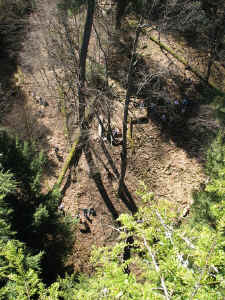
View from the Top |
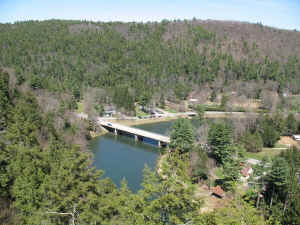
View from the Top looking toward the bridge on
Route 36 and Park Office |
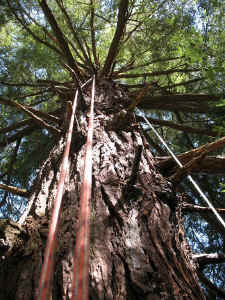
Looking Upward - Ropes on the Seneca
Hemlock |
So, a weekend full of new records and good data points. Overall,
I was
impressed and alarmed by the massive amounts of eastern hemlock
in NW PA.
The hemlock woolly adelgid will seriously alter the sites we
visited. Mile
upon mile of roadsides lined with hemlock will be corridors of
hazard trees.
Without treatment, large areas in places like Cook Forest will
need to be
closed, felled or logged if to remain "open" for
visitors. The impacts on
adjacent trees and wildlife are incalculable. Cook Forest is
such a heavily
used area that large scale treatments can be easily justified.
NOW is the
time to get a plan and funds into place. A place like Hearts
Content, with
its profound ecological and long-term monitoring significance
would be a
devastating loss. Since the site is so small it could be
effectively treated
in it's entirely to preserve the continuity of the studies
concurrently
being performed there. I just hope the pertinent managers will
see the HWA
threat as the huge beast that it really is and act promptly and
appropriately.
Will Blozan
President, Eastern Native Tree Society
President, Appalachian Arborists, Inc.
|